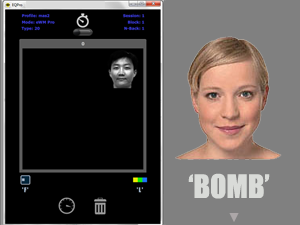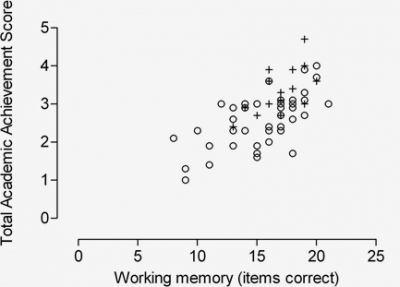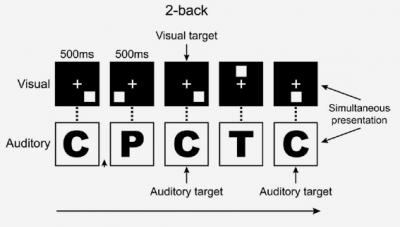In this blog article I explain the science behind the emotional dual n-back for increasing IQ and improving emotional regulation. It is a brain training game that has been widely discussed, and this is the only version that is available on the market. So how does it work?
The emotional dual n-back – basic concept
The emotional dual n-back is working memory training exercise. It modifies the standard dual n-back by using emotional content in place of abstract shapes and neutral letter/word sounds. The emotional content can be either visual (e.g. facial expressions) or verbal (e.g. emotionally charged words).
Training with the emotional dual n-back has the same benefits as standard dual n-back training but in addition it improves emotional executive control / emotion regulation (ER)– which the standard dual n-back does not. Not only are emotional dual n-back trainees able to selectively ignore distracting emotional content better, but also use relevant emotional information to speed up processing for cognitive tasks.
ER capacity is associated with a wide range of beneficial outcomes, such as better social relationships, better health and professional success (Gross, 2002). And mood and anxiety disorders have been linked to poor emotion regulation.
Let’s now review the basics.
What is working memory?
Working memory (WM) can be considered as the main control center of our cognition (thinking, decision-making, problem solving, comprehending, deliberate learning).
Working memory can be defined in everyday language as a set of skills that helps us keep information in mind while using that information to think something through, make a decision, pursue a goal or complete a task. Baddeley has defined it as:
a brain system that provides temporary storage and manipulation of the information necessary for such complex cognitive tasks as language comprehension, learning, and reasoning. (Baddeley, 2003, p. 189)
Working memory is necessary for staying focused on a task, blocking out distractions, keeping you updated and aware of what is going on in this process, and applying relevant cognitive strategies to process the information.
Working memory impairments result in loss of attentional focus – such as difficultly focusing on reading a text, or memory problems such as forgetting what to do in the few seconds of walking from one room to the another, or being easily distracted while trying to focus on a task and not being able to finish an activity according to plan.
In general terms, the larger your working memory capacity or ‘mental workspace’, the greater your capacity for higher order cognition and thus academic and professional achievement. An example of this relationship is shown below.
Brain basis of working memory: frontoparietal circuit
The brain regions for working memory are what is called the Frontoparietal network, involving the lateral and middle PFC (pre-frontal cortex) and the inferior parietal cortex. This is also known as the cognitive control network and is involved in a wide range of wide range of cognitive functions including general intelligence. The fronto-parietal circuit is shown in this brain scan:
Standard dual n-back working memory training: What is it?
The aim of all working memory (WM) training programs is to expand working memory capacity. The most widely studied brain training exercise targeting WM capacity is the dual n-back game. This game involves viewing a continuous stream of items (e.g., letters) and deciding whether each item matches the stimulus presented n stimuli back. In dual n-back training, a verbal and a visuo-spatial stream of items is presented simultaneously and item matches have to be detected for both types of information.
This dual task requires updating items in both the visual short term store and the verbal short term stores of working memory. The most well-known dual n-back task has been developed by Dr. Susanne Jaeggi and her colleagues back in 2008.
Known benefits of dual n-back working memory training
Working memory training has been shown in replicated studies to result in the following cognitive benefits (reviews: Morrison & Chein, 2011; Salminen, Strobach & Schubert, 2012):
- Increased performance on untrained measures of working memory and short-term memory.
- Fluid intelligence (IQ) – i.e. abstract reasoning and problem-solving abilities
- Multi-tasking – i.e. attentional selection between two sets of information associated with different tasks.
- Detaching attention from irrelevant items and attending to new relevant items.
- Shielding against interfering information.
- Episodic memory (memory for personal experiences).
- Reading comprehension.
- Verbal learning and every day attention in older adults (60+).
- Reduced symptoms of ADHD.
- Improvements for multiple sclerosis – everyday memory, quality of life.
- Improvements for schizophrenia patients – everyday memory, quality of life.
- Improvements for frontal lobe stroke patients.
Emotional dual n-back training – what is it?
The emotional dual n-back exercise is another type of working memory training. One exercise that has been implemented in HighIQPro and DNB Pro has been developed and studied extensively by Susanne Schweizer, Adam Hampshire and their colleagues at the Medical Research Council (MRC) Cognition and Brain Sciences Unit, Cambridge. This is shown in their diagram below:
What are the effects of emotional dual n-back training?
Emotional dual n-back training has the same effects as standard dual n-back training.
But in addition, it has benefits relating to emotion regulation and what is known as “affective (e.g. emotion-based) cognitive control”.
In the study by Schweizer et al (2011), there was good evidence for training based gains in IQ for both standard and emotional dual n-back training over 20 days. But the emotional dual n-back training had additional benefits:
“Specifically, we showed that only training on the dual n-back task using emotional stimuli got transfer gains on … a standard measure of emotional executive control. Importantly, there was no support for emotion-control transfer effects in participants who trained on the dual n-back task with neutral stimuli…. Participants got better at engaging with goal-relevant emotional material, while ignoring highly emotional material that is not pertinent or may distract from the target task.”
.
“Translating this into everyday life, such training may improve participants’ decision making in situations that require the manipulation of emotional material. Moreover, patients with emotional disorders that are characterized by difficulties in exerting cognitive control in order to selectively engage and disengage from affective information may benefit from such training (e.g., depression, anxiety disorders).”
In a follow up emotional dual n-back research published in 2013 the Cambridge MRC group has found the following:
- Emotional cognitive control relies on the same frontoparietal brain circuit as working memory (WM) tasks.
- 20 days of training on the emotional dual n-back successfully increased the efficiency of this frontoparietal network as well as other brain regions underlying emotion control (e.g. the anterior cingulate cortex known to be involved in mood regulation.)
- The anterior cingulate cortex (ACC) has been reliably shown to be involved in successful downregulation (dampening) of emotional distress through the use of various cognitive control strategies. This is via its inhibitory effect on the amygdala – which underlies emotional reactivity. The inhibitory effect of the ACC on amygdala activation is reduced in those at risk for depression.
The brain circuitry for emotion regulation is shown in this diagram. DNB Pro (and other emotional working memory exercises) target this circuitry, resulting in long-term neuroplasticity change.







